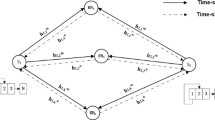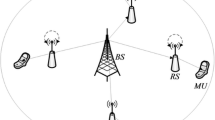Abstract
This paper addresses an optimal power adaptation (PA) problem of a two-time-slot bi-directional relaying network with a half-duplex amplify-and-forward relay. Unlike the existing studies, our goal is to develop effective PA strategies that can dynamically adjust the transmit-power levels of all the terminals to achieve energy efficiency, while satisfying the individual peak-power limit on each terminal and the quality-of-service (QoS) requirement of the network. By using the instantaneous channel state information (ICSI) and the statistical CSI (SCSI) knowledge, respectively, and with the aid of traffic information, the PA problem is analytically solved, leading to the so-called ICSI and SCSI based PA strategies with closed-form PA solutions for individual transmit-powers at the relay and the two end-terminals. Simulation results have verified the correctness of the derived expressions and confirmed the efficiency of our proposed strategies. It is shown that the proposed PA strategies can significantly reduce the total transmit-power of the network with guaranteed network QoS.






Similar content being viewed by others
References
Xu, C., & Wilson S. G. (2012). Minimizing transponder cost for two-way data exchange in satellite networking. In Proceedings of the 2012 IEEE international conference on communications, Ottawa, Canada (pp. 3250–3254).
Krikidis, T., Ding, Z., & Charalambous, C. D. (2012). Noncoherent energy detection with orthogonal signaling for an uncoded two-way relay channel. IEEE Transactions on Vehicular Technology, 61(1), 404–409.
Wang, R., Tao, M., & Liu, Y. (2013). Optimal linear transceiver designs for cognitive two-way relay networks. IEEE Transactions on Signal Processing, 61(4), 992–1005.
Rankov, B., & Wittneben, A. (2007). Spectral efficient protocols for half-duplex fading relay channels. IEEE Journal on Selected Areas in Communications, 25(2), 379–389.
Li, Y., Zhang, X., Peng, M., & Wang, W. (2011). Power provisioning and relay positioning for two-way relay channel with analog network coding. IEEE Signal Processing Letters, 18(9), 517–520.
Havary-Nassab, V., Shahbazpanahi, S., & Grami, A. (2010). Optimal distributed beamforming for two-way relay networks. IEEE Transactions on Signal Processing, 58(3), 1238–1250.
Zaeri-Amirani, M., Shahbazpanahi, S., Mirfakhraie, T., & Ozdemir, K. (2012). Performance tradeoffs in amplify-and-forward bidirectional network beamforming. IEEE Transactions on Signal Processing, 60(8), 4196–4209.
Ji, X., Zhu, W., & Massicotte, D. (2014). Adaptive power control for asymmetric two-way amplify-and-forward relaying with individual power constraints. IEEE Transactions on Vehicular Technology, 63(9), 4315–4333.
Jing, Y., & Shahbazpanahi, S. (2012). Max-min optimal joint power control and distributed beamforming for two-way relay networks under per-node power constraints. IEEE Transactions on Signal Processing, 60(12), 6576–6589.
Li, J., Ge, J., Zhang, C., Shi, J., Rui, Y., & Guizani, M. (2013). Impact of channel estimation error on bidirectional MABC-AF relaying with asymmetric traffic requirements. IEEE Transactions on Vehicular Technology, 62(4), 1755–1769.
Nisar, M. D., & Alouini, M.-S. (2014). Minimax robust relay selection based on uncertain long-term CSI. IEEE Transactions on Vehicular Technology, 63(2), 975–982.
Jing, Y., & Jafarkhani, H. (2011). Relay power allocation in distributed space-time coded networks with channel statistical information. IEEE Transactions on Wireless Communications, 10(2), 443–449.
Ji, X., Zhu, W., & Massicotte, D. (2015). Energy efficient power allocation and relay location for asymmetric bi-directional relaying. In Proceedings of the 3rd global conference on signal and information processing (GlobalSIP 2015), Orlando, USA (pp. 1–5).
Zhang, C., Ge, J., Cai, Y., Li, J., Ji, Y., & Farah, M. A. (2016). Energy efficiency and spectral efficiency tradeoff for asymmetric two-way AF relaying with statistical CSI. IEEE Transactions on Vehicular Technology, 65(4), 2833–2839.
Zhi, H., Yang, L., & Zhu, B. (2013). Jointing adaptive modulation relay selection protocols for two-way opportunistic relaying systems with amplify-and-forward policy. Wireless Personal Communications, 71(4), 2805–2825.
Ji, X., Zhu, W., & Massicotte, D. (2015). Transmit power allocation for asymmetric bi-directional relay networks using channel statistics. IET Communicatiuons, 9(13), 1649–1660.
Dankberg, M. D., Miller, M. J., & Mulligan, M. G. (1997). Self-interference cancellation for two-party relayed communication. U.S. Patent 5596439.
Ji, X., Zheng, B., Cai, Y., & Zou, L. (2012). On the study of half-duplex asymmetric two-way relay transmission using an amplify-and-forward relay. IEEE Transactions on Vehicular Technology, 61(4), 1649–1664.
Chung, P. J., Du, H., & Gondzio, J. (2012). A probabilistic constraint approach for robust transmit beamforming with imperfect channel information. IEEE Transactions on Signal Processing, 59(6), 2773–2782.
Goldsmith, A. (2005). Wireless communications (Vol. 57). New York: Cambridge University Press.
Acknowledgements
This work is supported in party by the National Natural Science Foundation of China (Grant Nos. 61371111, 61371112, 61371113, 61401238, and 61401241), and by the Natural Science Foundation of Jiangsu Province (Grant No. BK20140433).
Author information
Authors and Affiliations
Corresponding author
Appendices
Appendix 1
By the observation of (8), it can be found that the global minimum of (8) is achieved only when \(\gamma _A = \gamma _B = \upsilon\), and the final solution of (8), i.e., \(\left( {{\widehat{E}}_A ,\widehat{E}_B ,{\widehat{E}}_R } \right)\), yields the maximum \(\gamma _A\) and \(\gamma _B\) under the constraint \(E_A + E_B + E_R = {\widehat{E}}_A + {\widehat{E}}_B + {\widehat{E}}_R\). Thus, problem (8) can be decomposed into the following two sub-problems.
It’s worth-mentioning that a widely used approximation of the received SNR at the end-terminal as given by (37) is employed to facilitate the solution of (35) and (36).
where \(j = \left\{ {A,B} \right\} - i\). Then, by using some algebraic manipulations, (35) can be solved and its solution can be given by
Next, substituting (38) into (36) and performing some simple calculations, (36) can be solved straightforwardly and its solution can be given by the following expressions.
It’s noteworthy that (39)–(41) can be considered as the final solution of (8). However, since the approximate SNRs of the two end-terminals given by (37) are used to solve the optimization problems, the end-to-end data rates of the two ends cannot be stringently satisfied. To this end, we propose a scheme to modify the solution obtained above. By the observation, one can find that the received SNRs of the two end-terminals are both monotonically increasing functions of \(E_R\). Therefore, to satisfy the data rates of the two end-terminals, we modify \(E_R^{\mathrm{{II}}}\) in (41). Our idea is to increase the transmit-power level of \(T_R\) such that the resulting SNRs of the two end-terminals can satisfy the initial requirement. As explained, substituting \(E_A^{\mathrm{{II}}}\) and \(E_B^{\mathrm{{II}}}\) into (37) and letting \(\gamma _A = \gamma _B = \upsilon\) yields
So the final solution of (8) can be given by (39), (40) and (42).
Appendix 2
First of all, it can readily be obtained that \({\widehat{E}}_R\) is the maximum of \({\widehat{E}}_A\), \({\widehat{E}}_B\) and \({\widehat{E}}_R\). Thus, the MSOP can be rewritten as
Based on \({{a \mathord{\left/ {\vphantom {a b}} \right. \kern-\nulldelimiterspace} b} + {b \mathord{\left/ {\vphantom {b a}} \right. \kern-\nulldelimiterspace} a} \ge 2} {\text{for}} a,b > 0\) for \(a,b > 0\), we have
Thus, the MSOP can be upper-bounded as
Then, after some algebraic manipulations on (45), we can obtain the upper-bound of the MSOP as presented in Proposition 2.
Rights and permissions
About this article
Cite this article
Ji, X., Bao, Z., Xu, C. et al. Power Adaptation for Energy Efficient Bi-directional Relaying with Quality-of-Service Requirement and Individual Peak-Power Limit. Wireless Pers Commun 95, 2413–2435 (2017). https://doi.org/10.1007/s11277-016-3921-5
Published:
Issue Date:
DOI: https://doi.org/10.1007/s11277-016-3921-5




